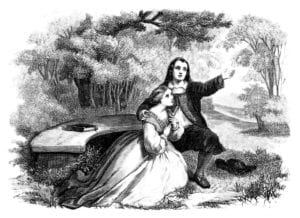Between the birth of his twins in 1585 and his emergence as a London dramatist in the early 1590s, Shakespeare disappears from view. There are several theories about his activities in these years. He may have spent the time in Italy, later the setting for around one third of his plays. Or he may have remained in England, working as a “schoolmaster in the country”, perhaps private tutor to a Catholic family in the north west of England. Equally he may have remained in Stratford, training as a lawyer – a conclusion reached by critics on the basis of his confident use of legal terminology and settings in various plays and sonnets.
Sonnet 30, which uses a legal metaphor in its opening couplet, is a well-known example:
When to the sessions of sweet silent thought
I summon up remembrance of things past ….
And the poem closes with an image possibly drawn from the law:
But if the while I think on thee, dear friend,
All losses are restor’d and sorrows end.
The poem is laced throughout with images of contracts and accounts that evoke the legal system. “Hamlet” offers a further example. In Act 5 Scene 1, when Hamlet has returned to Elsinore and Ophelia’s funeral, he brandishes a skull in the graveyard and speculates on its identity: “Why may not this be the skull of a lawyer?” he asks. “Where be his quiddits now, his quillets, his cases, his tenures and his tricks?” From examples like these, critics have speculated that Shakespeare may have had a background in the law, though whether he would agree with Dick the Butcher in “Henry VI Part Two” – “The first thing we do, let’s kill all the lawyers” – may be doubted.
The law in a general sense of the word plays a significant part in his plays. Whether it’s the authoritative Prince in “Romeo and Juliet” laying down the law to sanction Romeo’s stabbing of Tybalt – “And for that offence / Immediately we do exile him hence” – or the bumbling police officer Dogberry in “Much Ado About Nothing” advising his officers not to get too close to any thieves they may encounter – since “the less you meddle or make with them, why the more is for your honesty” – the application and impact of the law is never far away in Shakespeare.
One expression of this is the kind of trial scene which gives several of his plays a particular dramatic impact. The word “trial” has to be used here in a vague and general sense – the trial in “The Merchant of Venice” illustrates why this is so. The word is justified by the presence of lawyers and a judge for what is closer to an inquest. After all, who is on trial here? It seems at first to be Antonio who is facing the force of Venice’s legal system, but in the end it is Shylock who is judged and condemned. Nevertheless, the rudiments of a formal legal process are in place.
As soon as one begins to explore what is special about Shakespeare’s presentation of this trial, two features emerge that are entirely characteristic of his treatment of the legal process in his plays. The first of these is that the trial does not run smoothly, but becomes the arena for a dramatic episode as it develops – in this case the appearance of Portia, whose insight that a pound of flesh does not equate to a pint of blood suddenly breaks the gridlock and enables a solution of kinds to be reached.
A similar dramatic moment occurs in the trial of Hermione in “The Winter’s Tale”. The Queen of Sicilia is on trial for her life, having been accused by her husband Leontes of infidelity with his closest friend Polixenes. She denies the charge, and the audience believes she is innocent and her husband mistaken. She delivers several lengthy speeches in her own defence, a picture of humility and dignity, but Leontes is implacable, warning her that she “Shalt feel our justice, in whose easiest passage / Look for no less than death”. At this point two dramatic intrusions change everything: first messengers come from Delphos to proclaim unambiguously Hermione’s innocence; next, word arrives that the King’s son Mamilius has died under the pressure of events. Leontes immediately withdraws his accusation, and as Hermione faints, the trial breaks up in chaos.
The second of the consistent features of Shakespeare’s trials is the prominence of women, either as prosecutor (Portia) or accused (Hermione). These two features recur in “Henry VIII”, a play co-written by Shakespeare with John Webster. Here it is Catherine of Aragon who is on trial, and like Hermione, she is presented by Shakespeare as a picture of grace under pressure. Initially she asks for the trial to be delayed so that she can “Be by my friends from Spain advised”, but this is rejected by Cardinal Wolsey. In response Catherine refuses to accept Wolsey “for my judge” and resolves rather to “appeal unto the pope, / And to be judged by him”. And with this she announces “I will not tarry”, and she leaves the court.
Once again the two key features observed above are prominent here. The sudden dramatic gesture that changes the course of events recalls the two trials discussed above; and the prominence of women in the trial scene is clear. A fourth trial scene appears in another collaboration, “Arden of Feversham”, and it may be worth exploring this briefly for the light it may shed on the three scenes discussed here.
“Arden of Feversham” seems to have been written collaboratively in the early 1590s, around the time Shakespeare was finding his feet in the world of the London theatre. It seems likely that he was one of its authors, along with Thomas Kyd among others. The play explores the events leading up to the murder of the eponymous Arden, focusing on his unfaithful wife Alice and her unappealing lover Mosbie. The guilty are brought to court, their trial portrayed in the play’s penultimate scene. But although no fewer than ten characters – accomplices of the killers – are condemned to death, there is remarkably little drama in the scene, and the play ends on something of an anti-climax.
Is it possible that the apprentice playwright Shakespeare participated in the construction of this scene and made a private pledge to himself that if he ever wrote a trial scene into a play, he would lace it with the kind of dramatic moments explored above? It’s a tempting thought that the young playwright could see immediately the potential of a criminal trial and committed himself to exploring it when the chance arose and he was the master of the script. Alas, as with so much about Shakespeare, we can only imagine.




